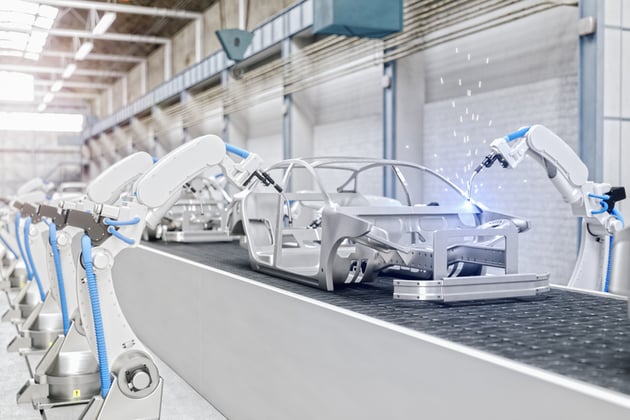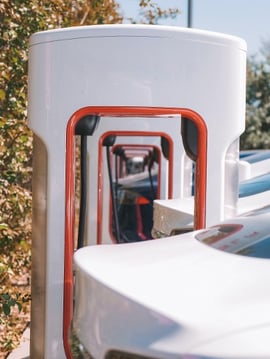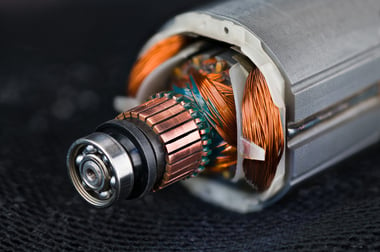Share this
EV Control Panel Trends: Electronic Units, Charging Stations & More
by Simcona on Mar 31, 2023 3:18:30 PM

From logistics and delivery to public transportation, the electric vehicle industry is gaining control. Now the industry’s manufacturers are trying to keep a different kind of control – control over the entire process, from concept to end use.
Dangers in and out of the factory – dust, chemicals, wind, heat, and moisture – are enemies to an industry that requires precise performance of sensitive equipment. At virtually every stage of the EV supply chain, industrial electrical panels deserve a spotlight for the value and protection they bring.
From EV charging stations to electronic control units in the vehicles themselves, here’s how industrial panels are powering the future of EVs and hybrids.
Where Does the Electric Vehicle Life Cycle Need Control Panels?
(Note: By “control panel” we mean the internal technology that performs key functions in a vehicle … not the buttons you press to play Metallica on your Spotify.)
Control panels are important to the growing EV trend in some critical ways:
- Safety of the public
- Efficiency of production
- Opportunity to innovate
This isn’t just true for the car or truck sitting in your drive. It’s true for pretty much any type of transport:
- Automobiles
- Connected vehicles
- Autonomous driving
- Last-mile delivery vehicles
- Public transportation
- Aviation & defense vehicles
Electric control panels are a key part of growing the industry’s infrastructure and technology:
- Charging stations
- Auto component manufacturing
- Automated assembly lines
- In the actual vehicle
1. The Charging Station
Also called EVSE (electric vehicle supply equipment) systems, charging stations include an array of ever-improving equipment and software for fast and safe EV energy delivery:
Something must house and protect the physical and functional integrity of these sensitive electronic parts. For electric car charging station manufacturers, that’s where industrial-grade control panels come in.
EV Chargers
The components of an EV charger include:
- Software (including communications protocols) that makes everything run
- Enclosure
- Plug
- Sensors
The control panel enclosure is where you’ll usually find the main relay, which turns the system on or off, and a power supply. It’ll also contain a control module that manages the relay. Some advanced control panels include an interface too.
Electric automakers are in for a challenge juggling the variables and applications possible with the “electrification” of transportation (and the charging solutions they’ll require). High-quality design and engineering – that’s customizable and easy to build and integrate – will ensure stations meet requirements for amperage, cable grounding, and communications.
EV Feeder Cabinets
In commercial applications, several EV charges might depend on a single feeder cabinet.
This box build contains controls that prevent current flow when the charger(s) isn’t in use. EV feeder cabinets can also detect hardware faults and break the charger-vehicle connection to stop electrical shorts, battery thermal damage, and fires.
EV feeder cabinets are mandatory infrastructure under NEMA standards due to the hazards of component exposure to weather. EVSE feeder enclosures protect internal parts while allowing users proper access to equipment.
2. Automation Lines for EV Assembly
Sometimes it feels like EV producers are in a (robotic) arms race to build the most efficient, automatic production line possible. More than any other application on this list, EV automation lines lean on industrial electric panels to maintain quality and efficiency of production.
To maximize manufacturing uptime, accurate and trustworthy controls are a must. Electronic panels house the controls, components, and interfaces capable of running automated lines in the most effective way possible.
In these complex industrial environments, panels may include:
- PLCs (programmable logic controllers)
- Network switches
- HMIs (human-machine interfaces)
- Contactors
- Other devices
On an assembly line that relies on robotics, a slight dip in performance can be costly as humans rush in to sort things out. That’s why in today’s EV world, more control panels are being installed to protect sensors, lasers, and all sorts of industrial equipment.
3. Auto Component Manufacturing
Many parts specific to EVs – like rotors and stators – also may use manufacturing equipment that requires a panel control for long-term efficiency.
These component designs are highly engineered and ask a lot of the various mechanical functions of their machinery. Designers don’t want faulty equipment hampering their concept’s potential.
Electronic control panels allow for next-level monitoring and control of production machinery and its performance data.
Panels provide the same benefits to component production as they do automated assembly lines, with the bonus of building a safer environment for humans. Electrical control panels offer the advantage of reducing worker interaction with the moving parts and pinch points inherent to these small, intricate pieces. Easy access to power controls allows operators to quickly cut off electricity if there’s a danger risk.
Much like charging stations, factory floors work better when their setup is adaptable to the environment and project-specific needs. A control panel manufacturer with specialized skills can develop a custom solution for efficient production of demanding rotor and stator designs.
4. In the Actual Vehicle
You operate a control panel of sorts every time you crank up the heat (or the music) in your car. But in electric and hybrid vehicles, control is starting to run much deeper than that.
Electronics engineers design electric vehicle control systems for not just the driver infotainment system, but also:
- Safety features (i.e. braking)
- Battery management systems
- Sensors for self-driving
- Power converters
- Collision avoidance radar
- Navigation systems
- Driver & passenger comfort
In electric vehicles, engineers generally call these electronic control units (or modules), collectively referring to them as the vehicle’s “computer.” ECUs never seem to stop getting more sophisticated – and smaller.
Despite this, because carbon footprint-minded vehicles must also have a small footprint in the literal sense, designs tend to be compact. This invites heat and electromagnetic interference (EMI) buildup. Protective enclosure boxes around electrical controls and cables can resist heat, reduce EMI between systems, and keep your design running reliably.
Automotive manufacturers are cooking up new and exciting ways to integrate technology into the end product. Between RADAR, LiDAR, GPS, and RF systems, you might as well consider today’s vehicles to be electronic machines, not mechanical ones. These advanced features will test the capacity and expertise of electronics engineers who build electronic panel components.
What Industrial Control Panels Will Mean to Your EV Product
There’s new opportunity to expand the reach of electric transportation. It’ll take some self-control to get there – industrial self-control, that is.
Faster installation and configuration, compatibility with automation, and safer interaction make industrial electric panels a logical choice for many applications along the EV life cycle. The streamlining of time, cost, and effort will make EVs more efficient for designers, assemblers, and users.
To learn more about optimizing your industrial controls and meeting exacting specifications, visit our resource blog:
Share this
- Components (39)
- Cost (29)
- Distribution (21)
- Materials (21)
- Cables & Wires (20)
- Supply Chain (19)
- Standards & Certifications (18)
- UL (17)
- Control Panels (16)
- Safety (14)
- Design (13)
- Contract Manufacturing (11)
- Inventory Management (11)
- News (10)
- Jacketing & Insulation (9)
- Suppliers (8)
- Wiring (8)
- Availability (7)
- Design & Engineering (7)
- Obsolescence Management (7)
- Testing & Prototyping (7)
- Maintenance & Downtime (6)
- Temperature & Fire Resistance (6)
- Enclosures (5)
- Manufacturing (5)
- Circuit Protection (4)
- Data Centers (4)
- Kitting & Fulfillment (4)
- Labeling (4)
- Sensors (4)
- Corrosion (3)
- Datacom (3)
- Cooling & Fans (2)
- Supplier Spotlight (2)
- Automation (1)
- Honeywell (1)
- PLCs (1)
- Relays (1)
- Security (1)
- November 2025 (1)
- October 2025 (1)
- August 2025 (1)
- July 2025 (6)
- June 2025 (4)
- May 2025 (4)
- April 2025 (3)
- March 2025 (11)
- February 2025 (3)
- January 2025 (2)
- December 2024 (1)
- November 2024 (1)
- October 2024 (1)
- September 2024 (3)
- August 2024 (1)
- July 2024 (4)
- June 2024 (3)
- April 2024 (2)
- March 2024 (1)
- January 2024 (1)
- October 2023 (1)
- June 2023 (1)
- May 2023 (1)
- April 2023 (1)
- March 2023 (2)
- October 2022 (1)
- March 2021 (3)





No Comments Yet
Let us know what you think